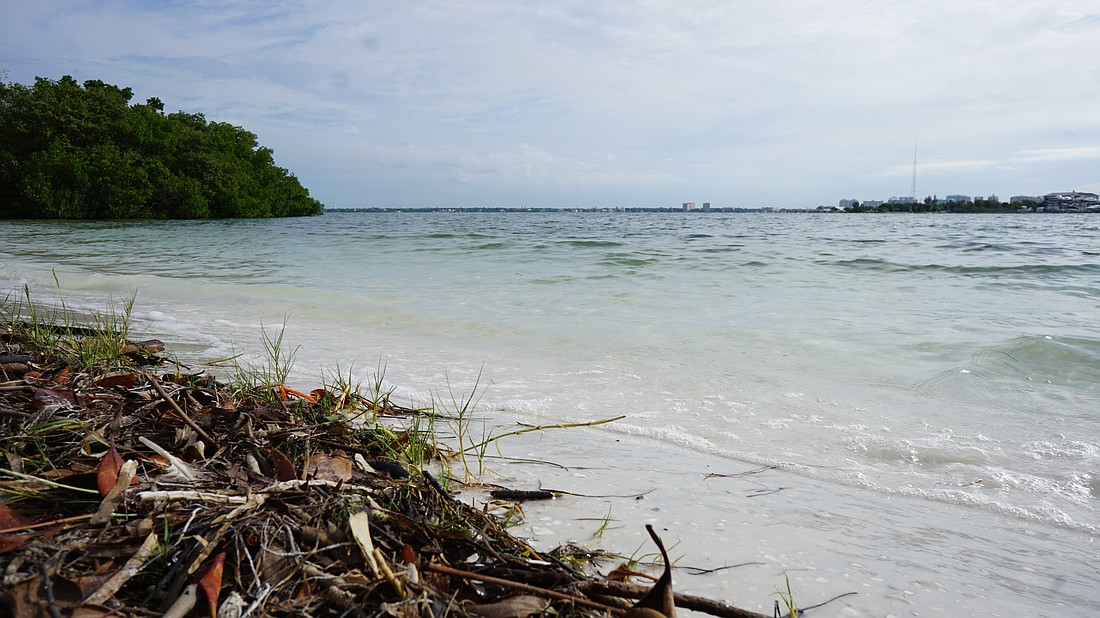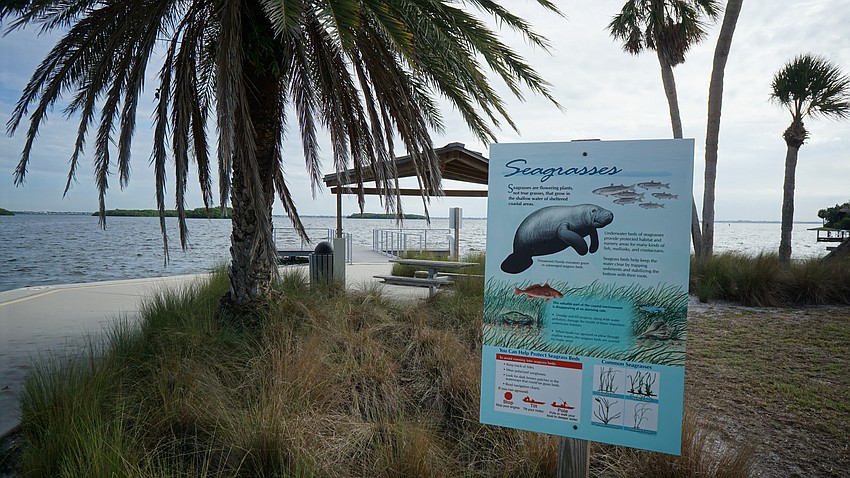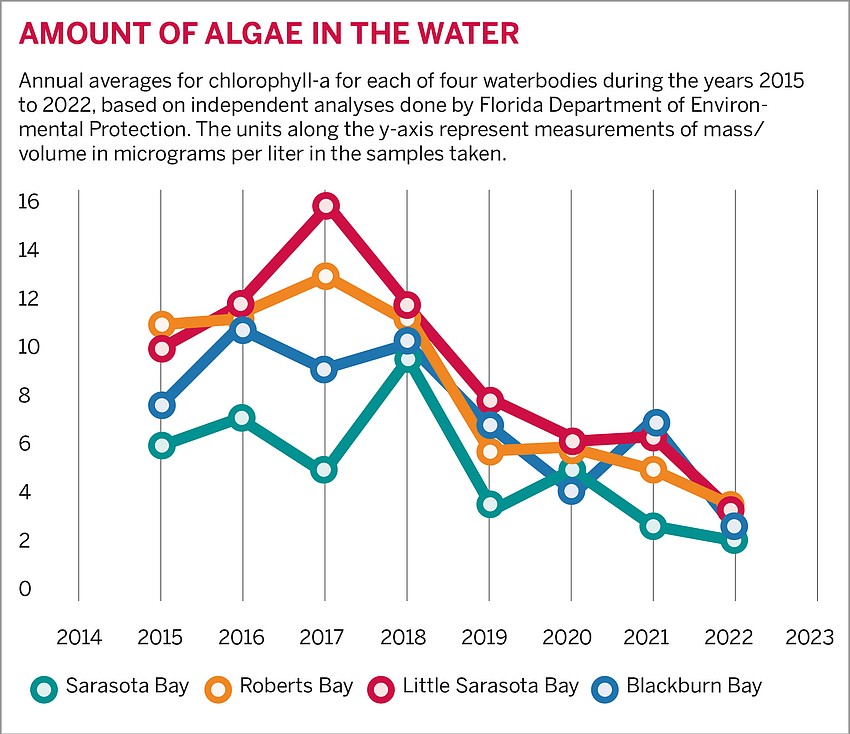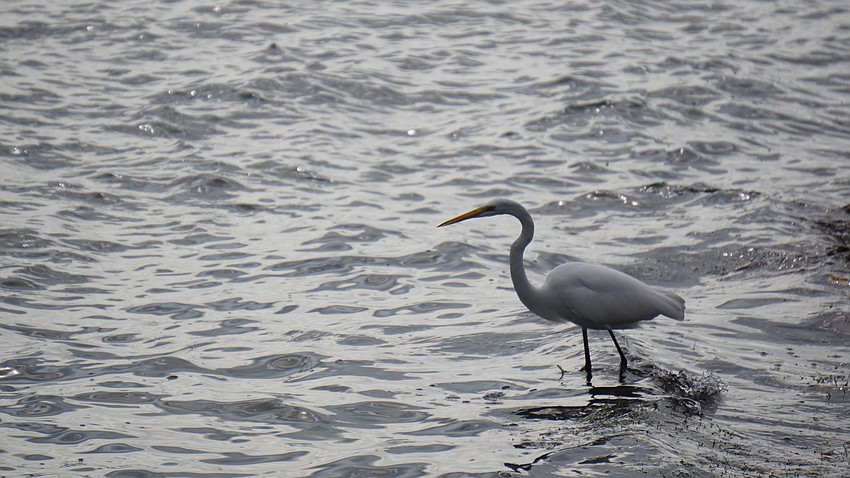- May 10, 2025
-
-
Loading

Loading

Sarasota Bay’s water quality is the best it’s been in eight years.
That’s what Executive Director of the Sarasota Bay Estuary Program Dave Tomasko said in his most recent director’s note.
But while it may be a good time to reflect on the positives, it’s not time to take a break.
We can’t let the water quality slip away again, Tomasko said.
He explained that in a recent meeting with colleagues at the Florida Department of Environmental Protection, he was told that FDEP would be releasing their “Draft Impaired Waters List” and “Draft De-List List.”
The lists summarize bodies of water that are considered out of compliance with water quality standards, and conversely those that are improving so much that they can be taken off the list.
From the conversation, he learned that Sarasota Bay, Roberts Bay, Little Sarasota Bay and Blackburn Bay will all be delisted for nutrient pollution.
Simply put, the algae in Sarasota Bay has decreased so much that the water meets the standards to be considered “good quality.”
“If you go out in the bay, you can tell the difference compared to where we were a few years ago,” Tomasko said.
The main nutrient in question is chlorophyll-a.
A higher amount of chlorophyll-a in the water is an indicator of more algae in the water. Chlorophyll is the molecule found in all plants that allows the organisms to absorb sunlight and photosynthesis.
Nutrients like nitrogen and phosphorus feed the algae.
If you want your lawn to be greener, you add nitrogen and phosphorus, Tomasko said. Likewise, if you wanted the bay to be more green than blue — meaning more algae than clear water — you would add more nitrogen and phosphorus.
The first part of that analogy is part of the problem: fertilizers containing nitrogen and phosphorus are common culprits of runoff issues.
More algae is like putting a blanket on your front lawn, Tomasko said in another analogy. The blanket suffocates the vegetation by preventing sunlight from reaching what lies below it.
Which is precisely what algae overgrowth does to seagrasses.
Seagrasses are important bases for ecosystems, providing food sources for fish, crabs, manatees and sea turtles.
Two of the most common seagrasses found around Florida, turtle grass and manatee grass, are named after the animals that consume the species as a main food source.

Tomasko said he’s already seeing these important seafloor forests recovering.
Between 2014 and 2018, Tomasko said the lower part of Sarasota Bay lost about 30% of its seagrass coverage. This was mostly related to a couple of very wet years, and problems with overwhelmed wastewater treatment facilities.
The biggest decline in recent years, according to Tomasko, occurred between 2018 and 2020 in the upper part of the bay, just southeast of Sister Keys. About 2,000 acres were lost.
This is believed to be associated with the red tide event that began in 2017, and had major impacts on the bay’s water quality.
Tomasko and colleagues with SBEP have been tracking that area for the last couple years, and have been seeing the potential for recovery.
Around mid-September, Tomasko said the amount of seagrass was impressive. They found an abundance all over the place.
Although aerial data of seagrass coverage won’t be taken for another year, Tomasko is hopeful.
“We think it's going to be a huge increase, maybe multiple hundreds of acres,” he said. “It was one of my best days out in the field.”

Aaron Zimmerman works with water quality for Sarasota County, where he’s been a part of the research since 2021.
Overall, he agrees with Tomasko’s observations. He’s also seen good trends for seagrass and a decreased abundance of macroalgae.
Zimmerman said what’s important about their research is that while aerial images take good readings of overall seagrass coverage, the work he does with his team is able to provide a more detailed look.
This includes seagrass coverage by species, the three most common ones being shoal, manatee and turtle grass.
Zimmerman said he can say firsthand from being on the water that it seemed clearer in terms of quality, most likely meaning chlorophyll levels are going down. This means algae production is also decreasing.
So all in all, reducing the amount of nutrients getting into the water will decrease the amount of algae in the water, which in turn will help water quality and allow seagrasses to recover.
Tomasko and scientists with Sarasota County agree that the most impactful reasons behind this good news are the improvements on the larger scale: upgraded stormwater and wastewater infrastructure.
A few examples Tomasko pointed out in his director’s note include the Bee Ridge Wastewater Treatment Plant upgrades of over $250 million, the county’s wastewater treatment plant improvements, the Celery Fields project and ongoing stormwater retrofit projects at the Bobby Jones Golf Course.
Heather Bryen has been with the county stormwater and water quality team since 2011, and has seen a lot of improvement projects big and small.
“They’re very committed to putting their money where their mouth is and getting the job done,” Bryen said.
Tomasko said the hundreds of millions of dollars that local governments are spending on wastewater and stormwater improvements are paying off by reducing the inflow of nutrients.
Though good news is worth celebrating, Tomasko urged it’s not time to say it’s good enough — this area has already made that mistake once before.
This time, Tomasko hopes bay residents have learned lessons from the past.
“It’s the re-restoration,” Tomasko said. “We already did it once and then we let it slip away, and now we’re trying to get it back again.”
In the mid-90s, Tomasko said a similar increase in water quality occurred. But, locals let that slip away due to the pressure of massive population growth, aging infrastructure, wetter weather and warming waters.
Now local officials are ensuring that everyone can do their part.

Mollie Holland is the coordinator of a county program called NEST, which stands for Neighborhood Environmental Stewardship Team.
In her words, NEST takes the large-scale problems and boils them down to the community level to show residents what they can do to be a part of the solution.
She’s even helped write a book, “Healthy Ponds Guide,” that is a comprehensive guide to being a water-conscious citizen.
Some things are easier to implement.
One of the most important ways people can help is to not be a part of the problem: by not overfertilizing lawns, not blowing grass clippings into the bay or drainage and to pick up after dogs.
By taking those suggestions into consideration, people can help prevent nutrients like nitrogen and phosphorus from entering the water system.
And some of these solutions are actually money savers, Holland said. Using less fertilizer is less expensive.
But when certain projects come with increased costs, Holland said it’s also her group’s job to educate people about the importance of these improvements.
“Sometimes you have to break a few eggs to make an omelet, and spend some money and invest in our future and our climate here,” Holland said.
Most residents want to be a part of the solution, she said, because the water and the environment are one of the state’s biggest draws.
“When you ask folks why they come here, yes, it’s the sunshine and the warm weather,” Holland said. “But nine chances out of 10 when you ask somebody why they’re here it’s because of the environment.”
Tomasko’s recent meeting with FDEP colleagues served another purpose — to set even higher standards for the bay’s water quality.
Sarasota Bay Estuary Program will be pursuing a reasonable assurance plan for Sarasota Bay, in collaboration with local governments, FDEP and the EPA.
The reasonable assurance plan, Tomasko said, will propose stricter water quality standards.
Higher standards aren’t meant to set the bay up for failure though, he said. It’s to ensure that the millions of dollars going into stormwater and wastewater projects aren’t put to waste — and to make sure the water quality doesn’t decline again.